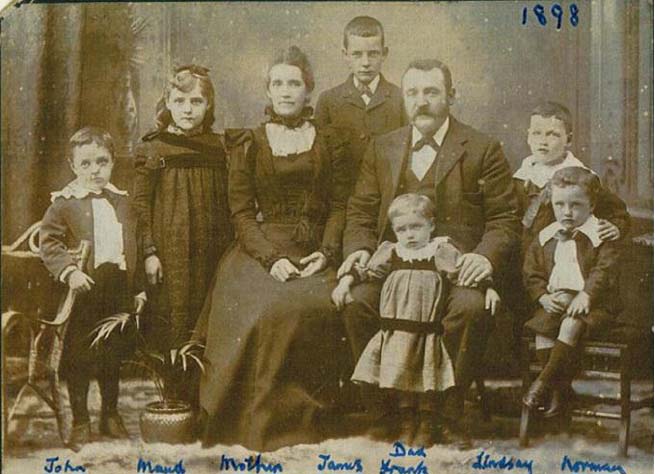
The Cowie Family, 18984
In August 2014 the world will mark the 100th anniversary of the outbreak of the First World War. The War had a significant effect on the demographic makeup of the civilian population of Scotland, and this chapter focuses on how it affected the number of births, deaths and marriages at home. It uses information taken from a series of reports about the civilian population by the Registrar General of Scotland from 1911 to 2013. Although these reports do not include similar information about the deaths of Scots on active service outside Scotland, estimates of military deaths are discussed. Scotland clearly made a contribution to the war in terms of numbers of personnel, but what was the impact of the war on Scotland's domestic population?
Over the course of the 20th century, life expectancy at birth increased substantially within Scotland. People in Scotland are now living around a third longer than the population a hundred years ago. In 1910-12, life expectancy for males and females was 50.1 and 53.2 respectively. By 2010-12, life expectancy for males was 76.5 and for females it was 80.7.
Compared to the present day, the age profile of the Scottish population has also changed significantly from 1914.
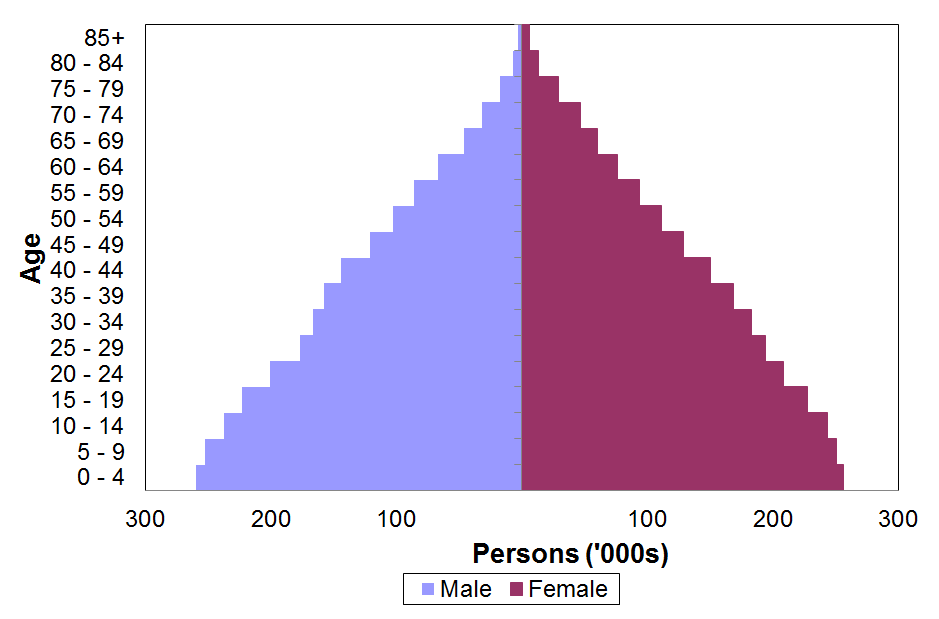
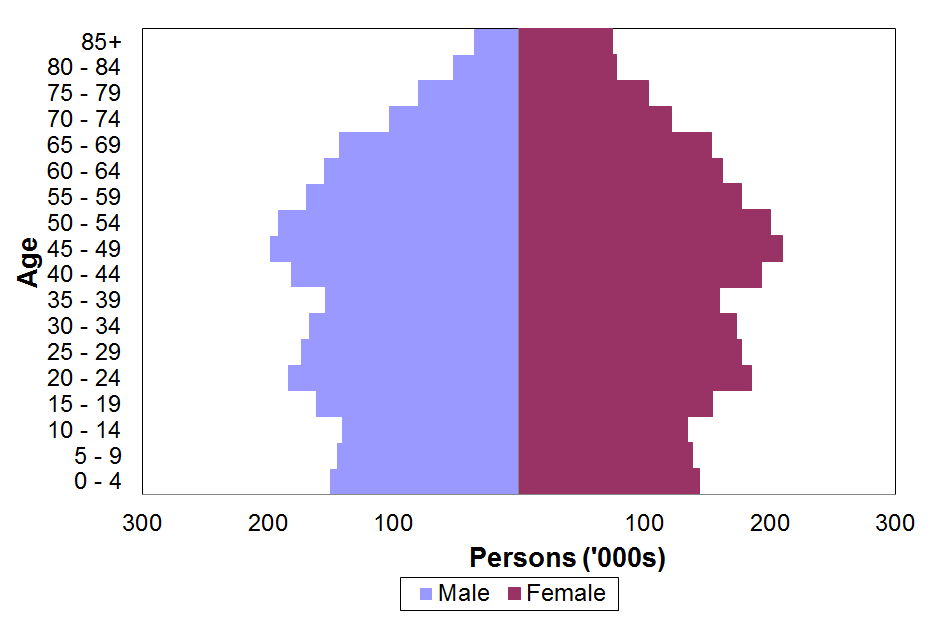
Figures 11.1a and 11.1b show the age structure of the population for 1914 and 2013 respectively. The age distributions show that over the last hundred years Scotland has experienced an increase in the relative numbers of people within higher age brackets, the highest numbers being in the 45-49 age group in 2013. In 1914 there are larger percentages of the population in the younger age groups, with each age group larger in size than the one born before it. These changes have come about through a mixture of scientific, healthcare and social advances as well as a falling birth rate.
In 1914 the estimated population in Scotland was around 4,747,000. This was greater than that of the previous year by just over 19,000 and was almost 14,000 less than the population in 1911 as measured in the census of that year. The infant mortality rate was 110.6 per thousand registered births.
The population rose steadily throughout the period of the First World War and this is shown in Figure 11.2.
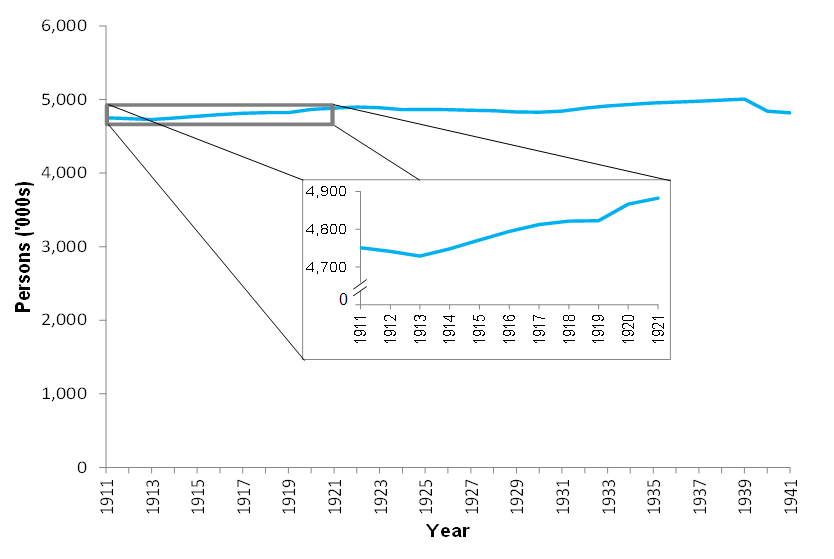
In 1914, 124,000 births were registered, and although this was slightly higher than the number of births in each of the years 1911, 1912 and 1913, it is lower than those in the preceding years all the way back to 1890.
The number of deaths registered in Scotland during 1914 was around 74,000, very similar to the previous year. The death rate in 1914 was 15.5 per 1,000 population and this was slightly higher than the preceding five years, but less than all years before 1909.
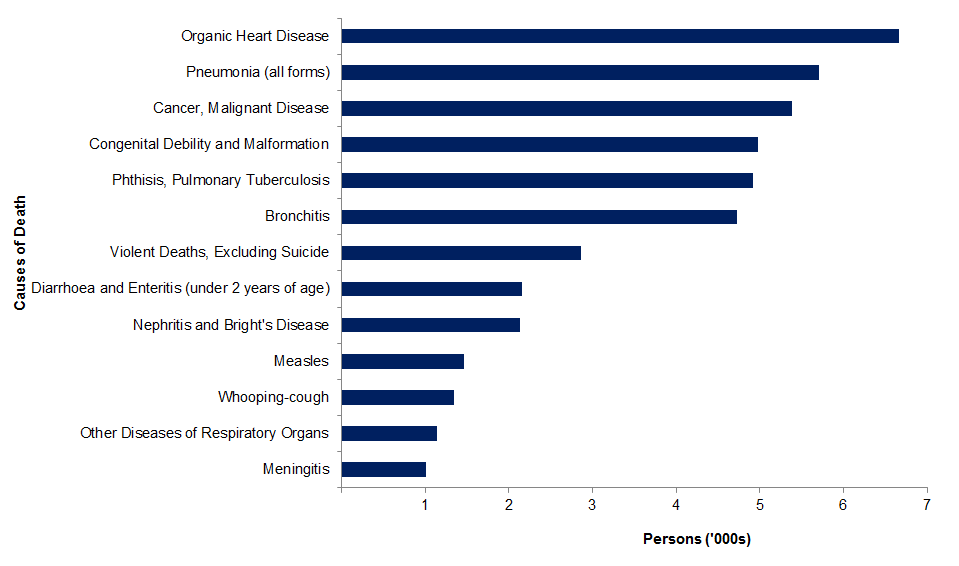
Figure 11.3 highlights the most common causes of death in 1914. Of these causes, Whooping-cough and Phthisis - (an archaic name for tuberculosis) saw a reduction compared to previous years.
There were just over 35,000 marriages registered in 1914, which at the time was the largest number of marriages ever registered in Scotland in one year, exceeding the peak recorded in 1913 by almost 1400. The majority of marriages in 1914 were registered in the first half of the year, nearly 20,000 from January to July (approximately 1,300, or 6.5 per cent more than in the previous year) while those registered from August to December, after the declaration of war on 4 August, amounted to over 13,000 - very similar to the previous year's number for the corresponding period.
By 1914 Scotland was already a very strongly urbanised society, and to a great extent the life expectancy and health of the people depended on their living conditions. Housing data provides an indication of conditions in which disease and chronic complaints could flourish. In 1911 some 12.8 per cent of Scottish dwellings consisted of a single room, and 40.5 per cent of only two rooms. Almost half (49.5 per cent) of the population lived in either one- or two-room houses. In some towns in the industrial central belt the percentage was much higher.1
After the outbreak of war, Scotland saw a large difference in the number of births from one year to the next due to the sudden and extreme differences in the numbers of young males remaining in Scotland. 1917 saw the fewest number of births registered in Scotland compared to any year previous with the exception of 18552, which was the first year of registration. This reduction in the amount of births is due to the fact that so many young males were abroad on military service after the outbreak of war in 1914.
Scotland saw a post-war bounce in births, so much so that 1920 was and still remains a record year. Almost 137,000 children were registered that year, 31,000 (29.7 per cent) more than the average of those of the preceding five years. This 'baby boom' was far more dramatic than the boom experienced at the end of the Second World War or in the 1960s. This is shown in Figure 11.4.
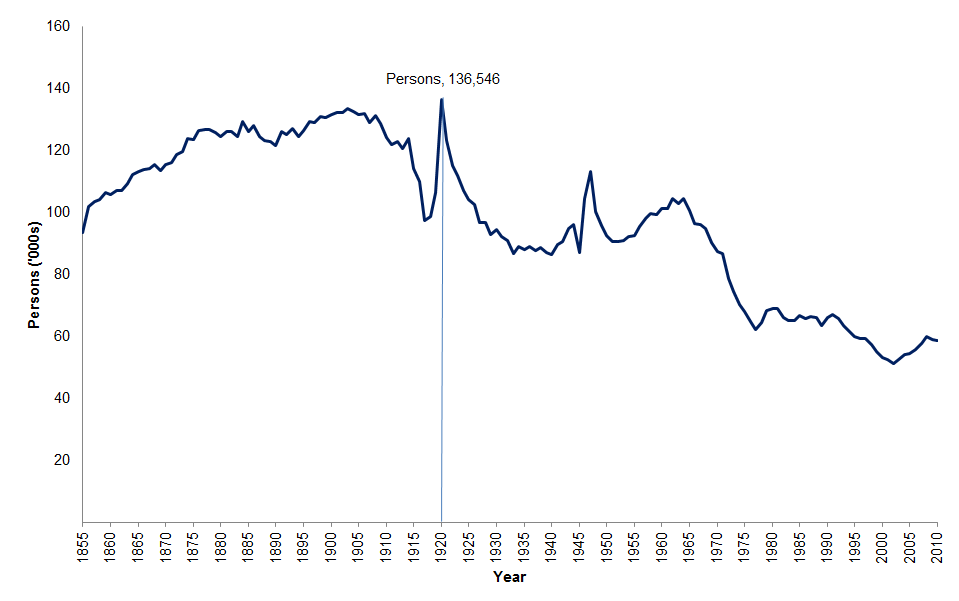
Figure 11.5 also shows the effect World War One had on the number of marriages. Before and during the early stages of war, Scotland was experiencing its largest number of weddings to date. However, soon after war commenced there was a significant reduction in this number. In 1916 there were about 5,000 fewer marriages than in 1915 and this number dropped by a further 1,000 to just over 30,000 marriages in 1917. This reduction may be attributed to the fact that many thousands on males were on active service overseas, therefore there were fewer unmarried males over the age of 15 living in Scotland, thus creating a gender imbalance.
The situation changed after the war ended. The number of marriages increased by approximately 4,000 in 1918, 10,000 in 1919 and 3,000 in 1920 reaching a peak of nearly 47,000. Throughout the rest of the 1920s, relative stability returned to the numbers of marriages.
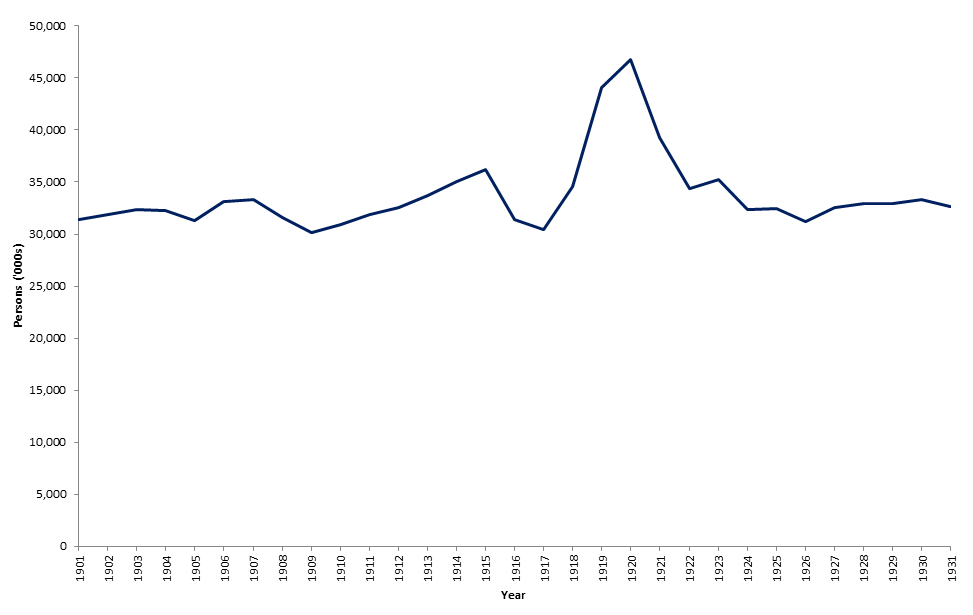
Since the outbreak of war, there were two peaks in the number of deaths in the civilian population of Scotland, one in 1915 and the other in 1918. This is illustrated by Figure 11.6.
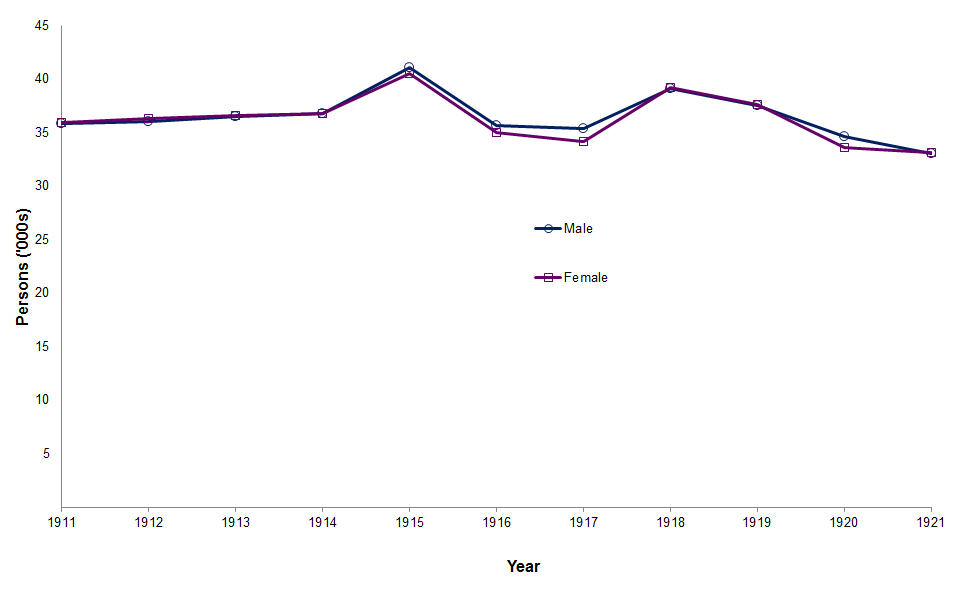
During 1915 there were nearly 82,000 registered deaths in Scotland. This was approximately 8,000 more than the previous year and about 7,000 more than in the preceding ten years. This was the largest number of deaths registered since 1900 with only six years before this having at least 80,000 deaths registered in a single year.
During 1918, the deaths of just over 78,000 persons were registered in Scotland. This number is nearly 9,000 more than that of the previous year and almost 5,000 more than the average of the preceding ten years.
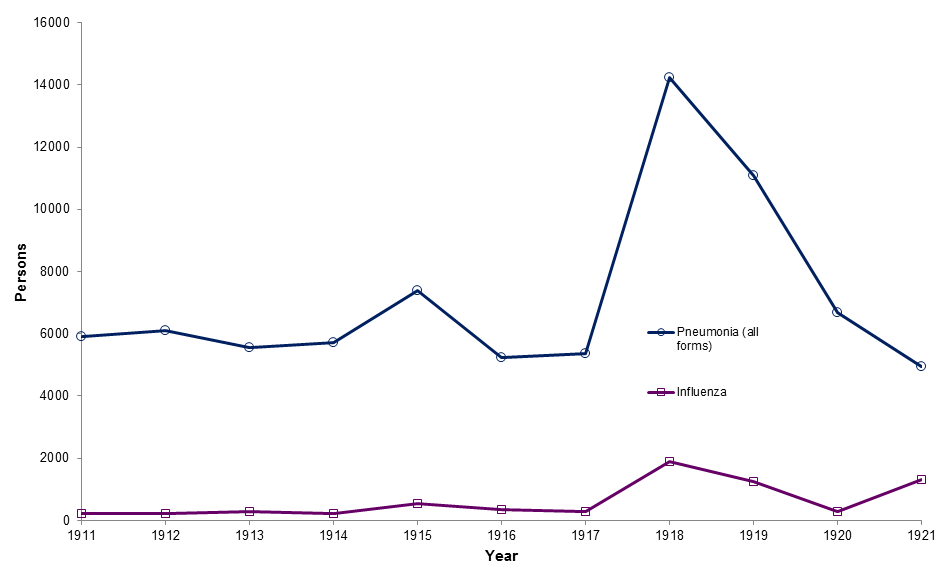
Figure 11.7 shows the high numbers of deaths registered in 1918 and this is associated with a severe pandemic of influenza. This pandemic, known at the time as 'Spanish Flu', is believed to have infected up to 500 million people worldwide, and resulted in between 50 and 100 million deaths. Most flu pandemics predominantly affect the young and old, but the Spanish Flu was particularly virulent amongst young adults. In many cases soldiers returning at the end of the war unwittingly brought the flu virus back with them. Doctors often cited pneumonia as the eventual cause of death on death certificates but often the influenza weakened resistance to other infections. The majority of the deaths in 1918 occurred in the months of September, October, November and December, preceded by a less severe peak in July. In these months the registered deaths from all causes numbered close to 15,000 more than in the corresponding five months of the previous year. In the previous seven months of 1918, the total number of deaths actually fell by nearly 6,000, and the number of deaths in Scotland during 1917 was lower than in all years since 1868.
Deaths of military and naval personnel are not reported in the Registrar General's annual reports, and a definitive total of the Scottish war dead has yet to be calculated. One postwar estimate was 100,000, while a more recent calculation suggested 110,000 deaths, equivalent to 10 per cent of the male population aged between 16 and 50. More than 148,000 names are recorded in the rolls of honour of the Scottish National War Memorial. This includes Scots from around the world who died serving the crown, including those who had emigrated. The rolls of honour, therefore represents an upper figure, which needs to be adjusted downwards to count only those living in Scotland in 1914.3
By 1919 the population of Scotland was estimated at 4,823,000. This was, at the time, the highest population since records began in 1855. This figure continued to grow, reaching a peak of almost 4,898,000 in 1922, in part due to the 1920 baby boom. The numbers of births saw a general decline in the 1920s, as did the total population after 1922, largely as a direct result of emigration. This is shown in Figure 11.8.
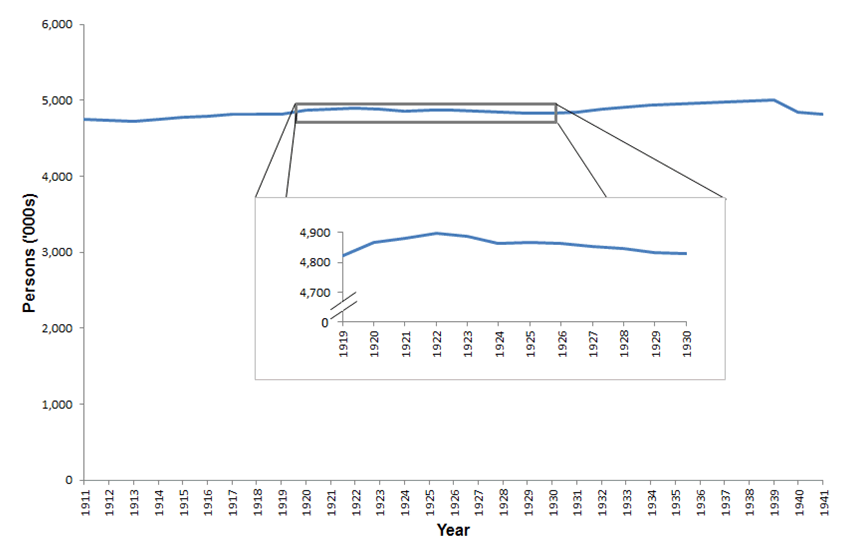
In 1919 the infant mortality rate was 101.6 per thousand registered births, this had seen a general reduction over the previous ten years. Life expectancy had also increased by the 1920s, in 1920-22 life expectancy for males and females was 53.1 and 56.4. This was roughly a three year increase for both genders since 1910-12.
Figure 11.9 shows the reduction of the number of 20-40 year old males within Scotland in 1919. This newly-formed gender imbalance was especially marked locally, as local regiments formed during the war had differing casualty rates. Before 1914, rural depopulation in the Highlands & Islands had already removed some younger working-age people, so that the deaths of young males during the war had a heavy impact in already depopulated areas. This changed the demographic makeup of certain towns and villages more than others across Scotland.
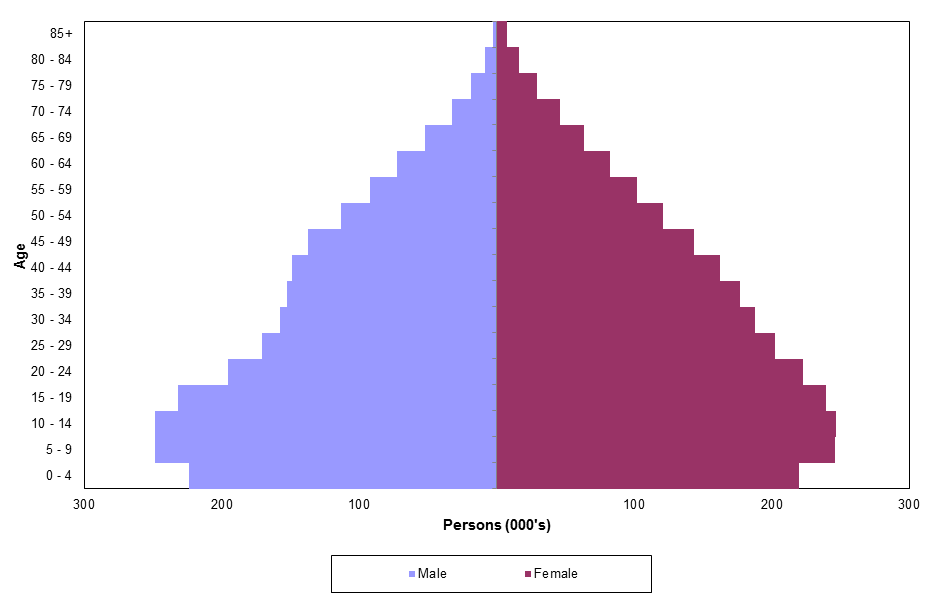
Figure 11.10 illustrates the general trends of births, deaths and marriages during the 1920s. Scotland saw a decline in the number of births after the 1920 peak with the greatest reduction taking place at the beginning of the decade. Marriages also fell after the 1920 peak, and remained relatively constant after the large reductions in 1921 and 1922. The number of deaths in Scotland was more volatile than the births and marriages over this period; however the peaks of 1922, 1924 and 1929 did not reach the levels of 1915 or 1918.
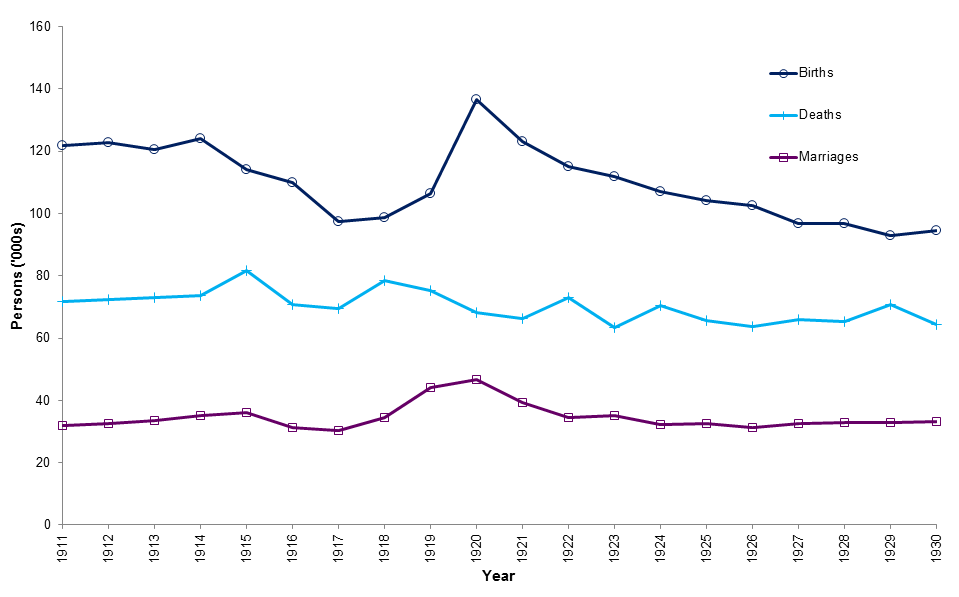
| Category | Census 1911 | Census 2011 |
|---|---|---|
| Natural Change | Natural change (births - deaths) over the previous 10 years was on average around 54,000 per annum. | Natural change is currently just under 2,000 per annum |
| Migration | Migration in the ten years previous to the 1911 Census was predominantly out of Scotland - an average of 25,000 per annum - much higher than measured by previous Censuses (going back to 1871). | In recent years (2003-2013) migration has been predominantly into Scotland at the rate of about 22,000 per annum |
| Rural Areas | The 1911 Census reported that nearly a quarter of the population of Scotland was located in rural areas. | Latest figures from Census 2011 indicate that the proportion living in rural areas has fallen to about 18.5 per cent |
| Centenarians | There were 24 centenarians in Scotland in 1911 | It is estimated that there were 780 centenarians in 2011 |
| Industries: It is difficult to directly compare the types of industries, but the headline figures for the number of people who reported their main employment in the different sectors are: | ||
| Agriculture and Fisheries | 240,000 | 50,000 |
| Finance | 27,000 | 114,000 |
| Mining and Quarrying | 169,000 | 34,000 |
| Manufacturing | around 560,000 | around 194,000 (including Shipbuilding) |
| Shipbuilding | 62,000 | |
| Public Administration | 100,000 (icluding Education) | 175,000 |
| Education | 212,000 | |
| Health | 14,000 | 377,000 |
| Construction | 88,000 | 200,000 |
| Gaelic Speakers | There were just over 200,000 Gaelic speakers in Scotland in 1911. | Latest figures from the 2011 Census indicate there are around 57,000 Gaelic speakers in Scotland. |
| Inhabited Houses | There were just over 1 million inhabited houses in 1911 with an average number of 4.7 people in each. | In 2011, there were around 2.4 million households in Scotland, with an average household size of 2.2 persons |
Statistical analysis of data on Scottish population and vital events is invaluable in providing an overarching view of the state of the country at particular periods in time. A detailed study of records of birth, marriage, death and census can add a different and more personal dimension to our understanding of life in Scotland.
In considering the impact of the Great War on Scottish society, there is no better way of experiencing it than through the life of a single family that had to cope with such change - the transition from the Victorian to the Edwardian era at the turn of the century, the outbreak of war and the loss of life followed by a rise in emigration beyond Europe in the hope of building a better future.

The Cowie Family, 18984
In August 1883, John Reid Cowie, a railway clerk from Glasgow, married Elspet Williamson in Turriff, Aberdeenshire. She was a farmer's daughter and James himself was the son of a farmer. He was aged 29 and she was 26 years old. Together they had 7 children, 6 boys and a girl, born between the years 1884 and 1896. James Williamson was the eldest, followed by William Alexander, then Maud, their only daughter, and four more sons Lindsay Steven, John Cameron, Norman Maitland and finally Frank Hamilton.
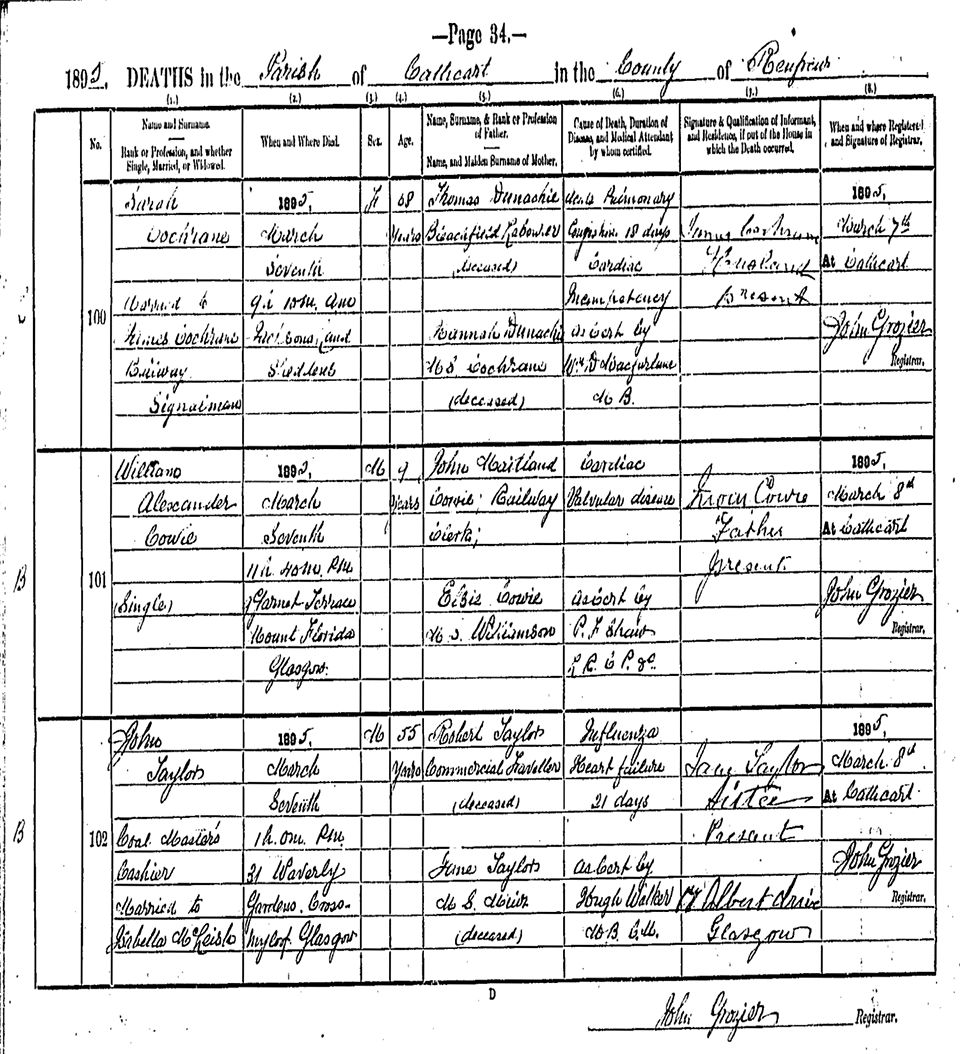
The large number of children was typical for this period, and like many families, the Cowies suffered the death of a child. Their second son, William appears in the 1891 census but is absent from the records in 1901. We find that he died in March 1895, aged 9, from cardiac valvular disease. Heart disease, in some cases brought on by rheumatic fever, was a common cause of death especially among the young.
The rest of the family survived childhood but the outbreak of war took its toll on their survival into adulthood. All of the five remaining boys served in the Great War and again the historical records reveal their fate.
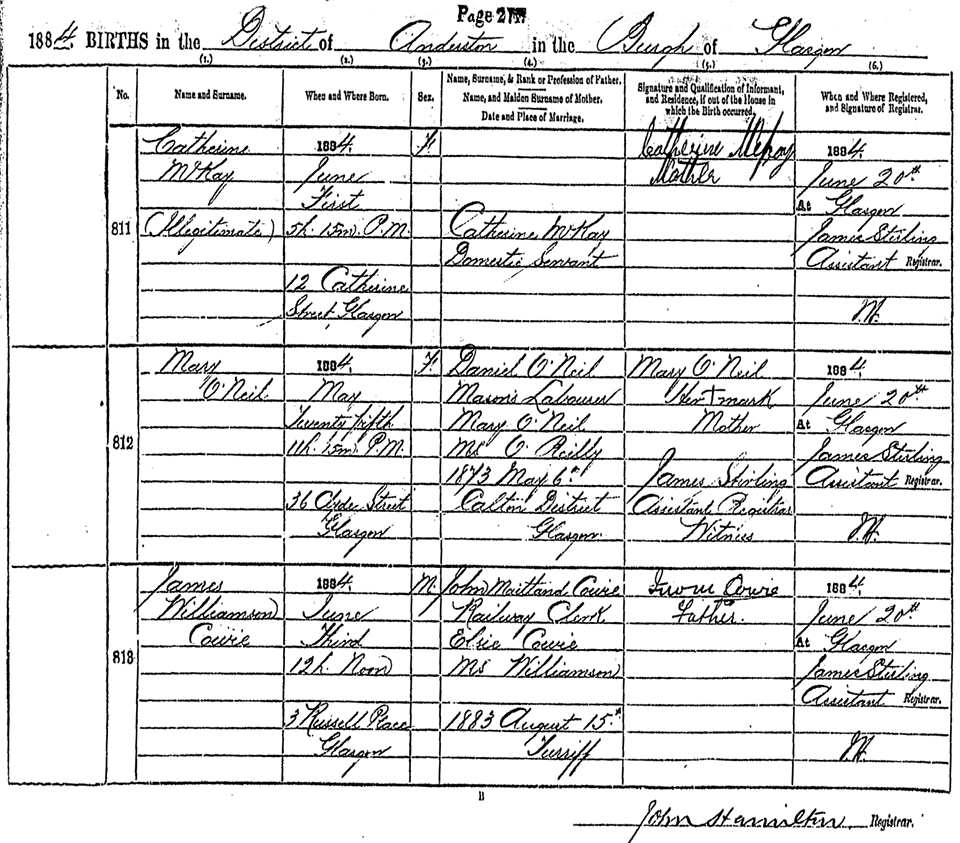
James was born in Glasgow in 1884. He worked as a postman and in June 1907, he married Margaret Tudor MacDonald in Govanhill. According to the 1911 census, they were living in Cathcart with 2 children. Following the outbreak of the war in August 1914, James served as an able seaman in the Royal Naval Volunteer Reserve. He was killed on 13 July 1915, leaving his wife to care for John, aged 5 and Elsie, aged 4.
Margaret did not remain a widow. As shown in Figure 11.6 'Marriages in Scotland, 1901-1931', there was a noticeable peak in the number that took place immediately after the war. Margaret is one of the people behind the statistics, as in June 1919 she married John Ballantine, a joiner, in Glasgow. However, they do not seem to have had children, and therefore did not contribute to the postwar baby boom. It is worth noting that Ballantine had one son from his first marriage, which had ended in 1916 with the death of his wife at the age of 30 from pulmonary tuberculosis. That year tuberculosis was the fourth biggest cause of death, and Glasgow had the highest death rates from the disease in Scotland.
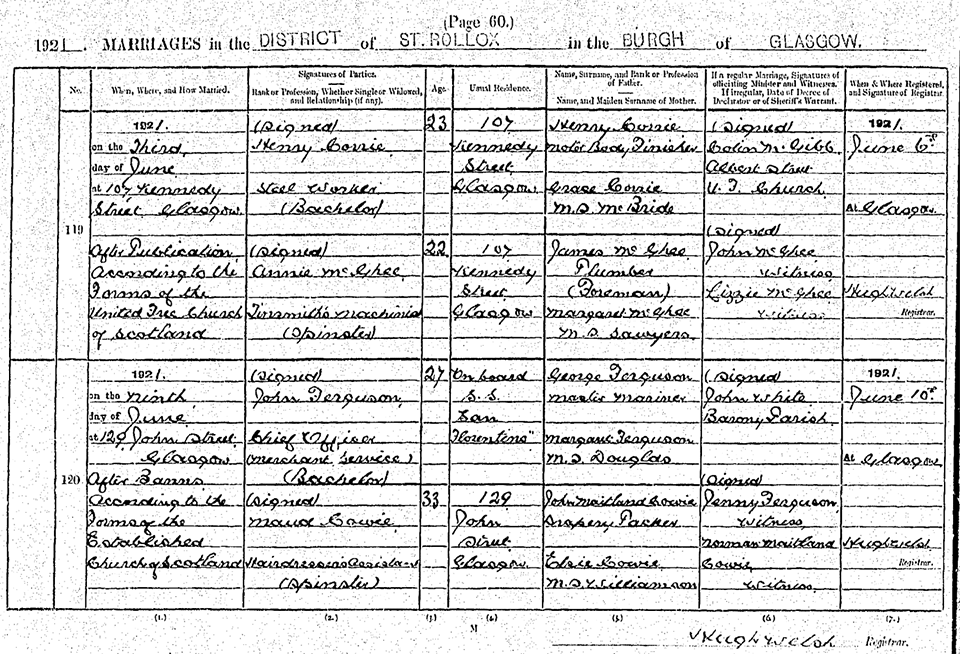
Maud was born in Glasgow in 1888. She worked as a hairdresser and remained single until 1921, when she married John Ferguson, a Chief Officer in the Merchant Service. She died in Gourock in 1942 of a heart condition, aged 54.
Lindsay was born in 1890. The 1911 census states that he was an unmarried office clerk. He enlisted and served in France as a private in the Queen's Own Cameron Highlanders. He died in the battle of Loos in 1915 on his 25th birthday.
John was born in 1892. He worked as a clerk in a distillery before the war. He was killed in action in France on 28 March 1915, aged 22, while serving in the Highland Light Infantry.
Norman was born in 1894. He fought in the war, was gassed on the Western Front and spent time in hospital. Afterwards he worked as a mercantile book keeper and in 1926 married in Glasgow. In 1928 he joined the many thousands of Scots who emigrated after the war, and sailed to South Africa. However, in 1934 he returned to Britain from Northern Rhodesia.
Frank was born in 1896 and at the outbreak of war was working as a warehouseman. In February 1916, according to Military Tribunal papers, he applied for exemption from service abroad at a time when two of his four brothers were posted as missing. It was later confirmed that three of his brothers had died on active service during 1915. He was recalled from France where he was a serving in the Royal Scots and was granted temporary exemption from service until March 1917. He served out the war in the Army Signal Corps in Bedfordshire, where he met his future wife. After the war he emigrated to Africa, and unlike his elder brother, became an increasingly successful trader and businessman, finally settling in South Africa, where he raised his family and died in 1975.
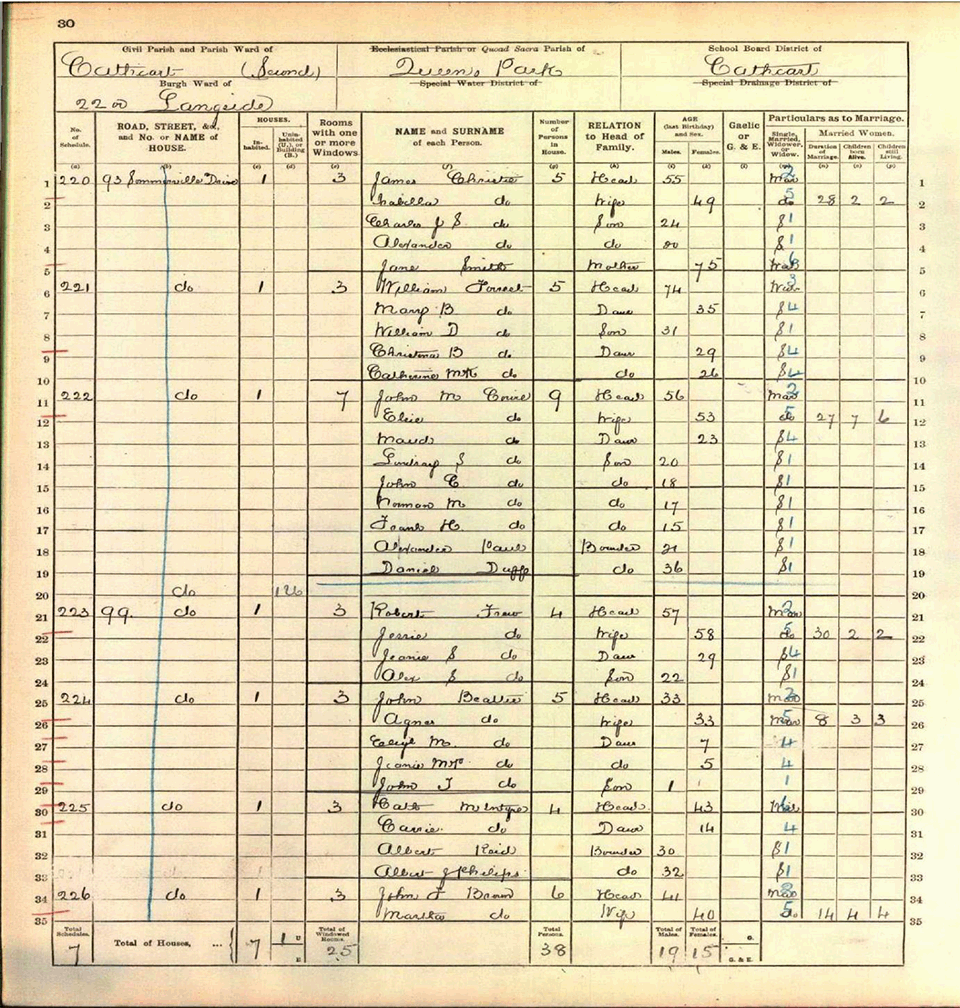
Footnotes: